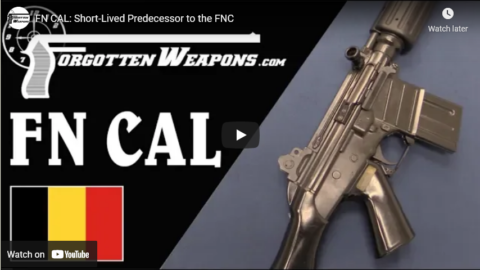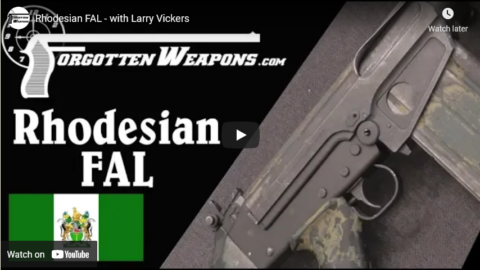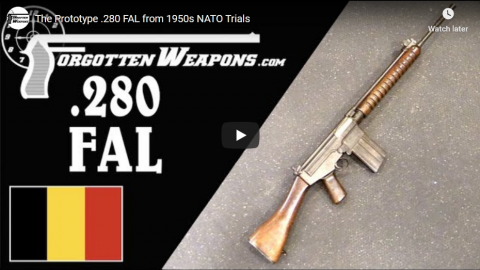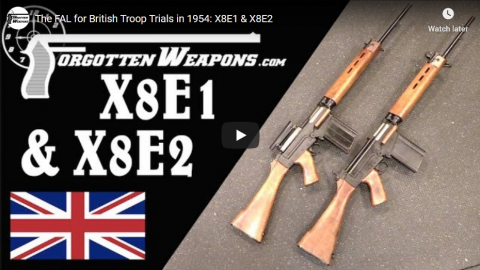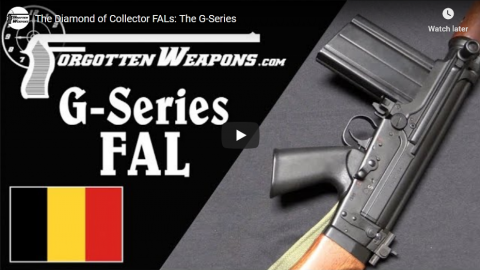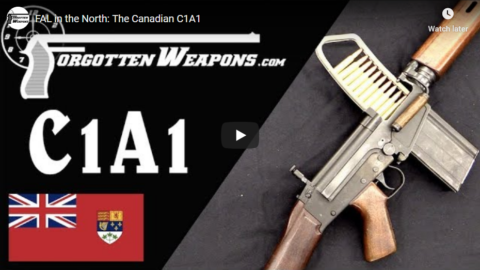On Target Canada
Published 20 Jan 2020Time to get a closer look at a rifle I have spent a lot of time with in the past. The FN C1A1, used by the Canadian Army from the mid 1950s to the late 1980s.
Enjoy!
(more…)
February 4, 2025
The FN C1A1 – Workhorse of the Cold War Canadian Army
January 26, 2025
The FAL in Cuba: Left Arm of the Communist World?
Forgotten Weapons
Published 7 Oct 2024The full version of this video, including the fully automatic fire not permitted on YouTube, is available on History of Weapons & War here:
https://forgottenweapons.vhx.tv/video…
In 1958, Cuban dictator Fulgencio Batista ordered some 35,000 FAL rifles from FN, including both regular infantry rifles have heavy-barreled FALO light machine guns. Before any of them could arrive, however, Batista fled the country and his guns were delivered to Fidel Castro beginning in July 1959.At this time, the FAL was still a fairly new rifle, having been first adopted by Venezuela in 1954 and Belgium in 1954/55. A few changes had been made by the time of the Cuban contract (like the slightly taller sights requested by the Germans), but these were still Type 1 receivers with early features.
The first consignment of rifles arrived from Belgium to Havana July 9, 1959 and this consisted of 8,000 rifles and ten LMGs. A second shipment of 2,000 rifles arrived October 15th, and a third of 2,500 rifles and 500 LMGs on December 1st. The final ship bringing FALs to Cuba (the French freighter La Courbe) docked in Havana March 4th 1960, and suffered a pair of explosions while bring unloaded. Several hundred people were killed or injured, and Castro blamed the CIA for the event. In total, the Cubans received 12,500 FAL rifles and 510 FALO light machine guns.
The FALs were used, but many ended up being exported to other parties, as Cuba generally moved to Soviet bloc small arms starting in 1960 (when they began receiving weapons from the USSR and Czechoslovakia). These were often scrubbed of their Cuban markings before shipment, and can be found with a round hole milled in the magazine well where the Cuban crest originally was, similar to how some South African FALs were scrubbed before being sent to Rhodesia.
Thanks to Sellier & Bellot for giving me access to this pair of very scarce Cuban FALs to film for you!
(more…)
March 30, 2024
Extra Firepower for Vietnam: the Aussie “B!tch”
Forgotten Weapons
Published Dec 18, 2023Many of the special forces groups that operated during the Vietnam War found their standard issue weapons a bit unwieldy for use in confined jungle environments. They also found a need for something that could deliver an immediate large volume of fire to break contact during an ambush (or deliver an ambush of their own). The Australians were no exception, and with the typical Special Forces attitude towards customization a few guys made some improvements to what they were issued …
What we have today is a recreation (by Mark Graham of ARS, build on a DSA semiauto receiver) of an Australian L1A1 with its flash hider cut down and a second pistol grip mounted to the barrel. The real examples of these often had rather shorter barrels, and ones that began life as semiauto L1A1 rifles were typically converted to fully automatic (some began as L2A1 automatic rifles and did not require this extra step). Fitted with a large LMG magazine, they could deliver a lot of firepower in a very short time; just the ticket for a small jungle patrol.
(more…)
October 7, 2023
Rearming West Germany: The G1 FAL
Forgotten Weapons
Published 19 Jun 2023Today we are taking a look at a German G1 pattern FAL. The initial purchased of the G1 were actual made by the German Border Guard (the Bundesgrenschutz). In the aftermath of World War Two, the western Allies decided to perpetually disarm Germany, and German security was provided by French, British, and American forces. As the Iron Curtain fell across Europe, that attitude softened — West Germany was on the front lines of the Cold War, and could be a valuable ally against Communism in the East. Thus in 1951, the West German Bundesgrenzschutz (Border Guards) were formed and armed — basically with all WW2 Wehrmacht equipment. Looking to improve its small arms in 1955/56, the BGS tested a number of modern rifles and decided to adopt the FAL.
The BGS initially ordered 2,000 FAL rifles from FN, with wooden hand guards and a fixed flash hider (essentially a standard Belgian FAL) — these are known as the “A” pattern. A second BGS order for 4,800 more rifles followed, this time of the “B” pattern with a metal handguard and folding bipod. This was the first use of an integral bipod on the FAL, and would go on to be a popular option for other buyers.
In 1955, the German Army was reinstated as the Bundeswehr. Looking over the BGS rifle testing, the Bundeswehr also decided to adopt the FAL, and placed and order for 100,000 rifles — the “C” pattern. These include sights lowered 3mm by specific German request, as well as a set of swappable muzzle devices (flash hider and blank-firing adapter).
Ultimately, FN was unwilling to license FAL production to West Germany, and this drove the Germans to adopt the Spanish CETME as the G3 rifle, which it was able to license. The Bundeswehr G1 rifles were eventually transferred to the BGS and later sold to other allies as surplus.
Special thanks to Bear Arms in Scottsdale, AZ for providing access to this rifle for video!
(more…)
July 21, 2023
Belgian Gendarmerie FAL w/ DSA Receiver
Forgotten Weapons
Published 24 Apr 2023A few months ago FN America was able to import 400 parts sets from original Belgian Gendarmerie FAL rifles. I got one of them, and had it completed by DSA. They made receivers with Gendarmerie markings, as well as the barrel and other parts not included with the kit. So today we’ll take a look at the finished rifle and the work that went into completing it.
(more…)
August 12, 2021
FN CAL: Short-Lived Predecessor to the FNC
Forgotten Weapons
Published 4 Jan 2019http://www.patreon.com/ForgottenWeapons
Cool Forgotten Weapons merch! http://shop.bbtv.com/collections/forg…
The CAL (Carabine Automatique Leger; Light Automatic Carbine) was FN’s first attempt to produce a 5.56mm rifle as a counterpart to the 7.62mm FAL. While light and handy, the CAL was a relatively complex and expensive design, and failed to garner many sales. About 12,000 were made in total before FN pulled the gun in favor of the FN FNC, which would prove to be much more successful.
Contact:
Forgotten Weapons
PO Box 87647
Tucson, AZ 85754
August 8, 2021
Australia’s FAL-Based L2A1 Heavy Automatic Rifle
Forgotten Weapons
Published 21 Apr 2021http://www.patreon.com/ForgottenWeapons
https://www.floatplane.com/channel/Fo…
Cool Forgotten Weapons merch! http://shop.forgottenweapons.com
Many the nations that adopted the FAL (or L1A1, in Commonwealth terminology) opted to also use a heavy-barreled variant of the same rifle as a light support weapon. In the Commonwealth, this was designated L2A1 and it was used by Canada, Australia, and New Zealand. The Australian model was build at Lithgow and supplied to the Australian and New Zealand forces, as well as being exported to a variety of other nations including Ghana, India, Singapore, Malaysia, Papua New Guinea, and others (total Lithgow production was 9,557). It has a 21″ heavy barrel and a distinct folding bipod with wooden panels that act as handguard when the bipod is folded up. Doctrinally, the L2A1 was intended to be used in semiauto most of the time, with the bipod and heavy barrel allowing greater sustained semiauto fire than a standard rifle.
A 30-round magazine was developed and issued, but abandoned before long. It was found to be insufficiently reliable, interfered with prone shooting, and contributed to overheating of the guns. Interestingly, Australia also opted to not have an automatic bolt hold open functionality in their FAL type rifles. The control can be used manually, but the rifle does not lock open when empty. This was presumably done in favor of keeping the action closed and clean at the expense of slower reloading (the same compromise was made on the G3 family of rifles).
This particular example is a registered transferrable machine gun made on a Lithgow receiver imported by Onyx in 1985 with other Lithgow-produced parts, including a 1960 bolt, 1961 carrier, and 1961 lower receiver from an L1A1 originally exported to Malaysia.
Contact:
Forgotten Weapons
6281 N. Oracle 36270
Tucson, AZ 85740
July 16, 2021
Rhodesian FAL – with Larry Vickers
Forgotten Weapons
Published 1 Jul 2018http://www.patreon.com/ForgottenWeapons
Cool Forgotten Weapons merch! http://shop.bbtv.com/collections/forg…
The iconic weapon of the Rhodesian Bush War is the FN-FAL, painted in a distinctive “baby poop” yellow and green pattern. Because Rhodesia was under international embargo, its options for obtaining weapons were limited. Some domestic production was undertaken, but one large source was neighboring South Africa. Both South African production FALs and also Belgian-made South African contract FALs were provided. This rifle is one of the latter, with the South African crest and proof marks defaced for some theoretical deniability should it be scrutinized.
Larry Vickers will talk us through this FAL, pointing out the different elements that are distinctly Rhodesian, as well as the unique Halbeck Device — and detachable muzzle brake.
Thanks to Larry for sharing this rifle with us!
If you enjoy Forgotten Weapons, check out its sister channel, InRangeTV! http://www.youtube.com/InRangeTVShow
Contact:
Forgotten Weapons
6281 N Oracle #36270
Tucson, AZ 85704
November 2, 2020
L1A1 SLR good and bad points
Bloke on the Range
Published 19 Oct 2017Sometimes Enfield does things right. Normally when they’re just polishing up an existing design. Like the L1A1 SLR, the British version of the FN FAL.
February 25, 2020
The Prototype .280 FAL from 1950s NATO Trials
Forgotten Weapons
Published 24 Feb 2020http://www.patreon.com/ForgottenWeapons
https://www.floatplane.com/channel/Fo…
Cool Forgotten Weapons merch! http://shop.bbtv.com/collections/forg…
After World War Two, the new NATO defense alliance held a series of trials to adopt a standard cartridge and infantry rifle. This would eventually devolve and the goal of a standardized rifle would be abandoned, but during the early trials there were three main contenders: the British EM-2, the American T-25, and the Belgian FAL. The Fusil Automatique Leger was designed by Dieudonne Saive and originally presented to the British government in 8mm Kurz, before being scaled up to accommodate the British request to use the .280 cartridge. A small number of these prototype FAL rifles in .280 were delivered by FN, and used in the 1950 NATO rifle trials.
Many thanks to the Royal Armouries for allowing me to film and disassemble this very scarce trials rifle! The NFC collection there — perhaps the best military small arms collection in Western Europe — is available by appointment to researchers:
https://royalarmouries.org/research/n…
You can browse the various Armouries collections online here:
https://royalarmouries.org/collection/
Contact:
Forgotten Weapons
6281 N. Oracle #36270
Tucson, AZ 85740
February 22, 2020
The FAL for British Troop Trials in 1954: X8E1 & X8E2
Forgotten Weapons
Published 21 Feb 2020http://www.patreon.com/ForgottenWeapons
https://www.floatplane.com/channel/Fo…
Cool Forgotten Weapons merch! http://shop.bbtv.com/collections/forg…
The NATO rifle trials of the early 1950s eventually chose the 7.62mm x 51mm cartridge, and the British and Belgians agreed on the FAL rifle to shoot it (and they thought the US would as well, but that’s another story). The British government formally accepted the FAL for troop trials, and in 1954 an order for 4,000 X8E1 rifles (with iron sights) and 1,000 X8E2 rifles (with SUIT 1x optical sights) was placed. These rifles were mechanically the same as what would be finalized as the L1A1 rifle, but they include a number of differing features. Both models had 3-position selector switches allowing automatic fire, and they also had manual forward assists on the bolt handles. The iron sights had top covers with integrated stripper clip guides, as there was concern that troops would have to manually reload their magazines, and stripper clips would speed this process up.
Many thanks to the Royal Armouries for allowing me to film these very scarce trials rifles! The NFC collection there — perhaps the best military small arms collection in Western Europe — is available by appointment to researchers:
https://royalarmouries.org/research/n…
You can browse the various Armouries collections online here:
https://royalarmouries.org/collection/
Contact:
Forgotten Weapons
6281 N. Oracle #36270
Tucson, AZ 85740
January 26, 2020
The Diamond of Collector FALs: The G-Series
Forgotten Weapons
Published 2 Apr 2018Sold for $17,250.
When the Browning Arms Company first began importing semiautomatic FAL rifles from FN in 1959, the submitted an example for evaluation, and ATF determined that it was not a machine gun. The rifle was made with a selector that could not be moved to the fully automatic position, and did not have the automatic sear required for full auto firing. This was acceptable at the time, and Browning would import 1,836 of these rifles (mostly standard configuration, but some heavy barrel and paratrooper patterns) by January 10, 1963. On that date, ATF changed its standard, and ruled the FAL as currently being imported now would be considered a machine gun subject to the NFA. In order to be acceptable now, the rifle must not be able to accept an automatic sear at all, not merely be made without one. However, ATF ruled that the previously imported guns would be grandfathered in, and remain legally owned as semiautomatic rifles. They were listed by serial number (an additional 12 guns were added in 1974 which were imported by “administrative error”), and remain exempted from the NFA to this day. For the FAL collector, these G-series rifles are desirable because they are completely authentic and original early FN production guns, without any of the design changes that would be required later for importation.
Exempt serial number list: http://www.gseriesfal.com/docpages/91…
http://www.patreon.com/ForgottenWeapons
Cool Forgotten Weapons merch! http://shop.bbtv.com/collections/forg…
If you enjoy Forgotten Weapons, check out its sister channel, InRangeTV! http://www.youtube.com/InRangeTVShow
September 7, 2019
C2A1: Canada’s Squad Automatic FAL
Forgotten Weapons
Published on 6 Sep 2019http://www.patreon.com/ForgottenWeapons
Cool Forgotten Weapons merch! http://shop.bbtv.com/collections/forg…
Canada was the first country to formally adopt the FN FAL as its standard service rifle, and in 1958 it added the C2 light machine gun version of the FAL to its arsenal. The C2, later updated to C2A1, was a heavy-barreled version of the regular FAL rifle. It shared all the same basic action components, but with a dual-use bipod/handguard, a rear sight calibrated out to 1000 meters, and 30-round magazines as standard. The gun was mechanically fine, but not a great light support weapon, as its rifle lineage sacrificed handling and sustained fire capability. Only about 2700 were produced, and it was ultimately replaced by the C9 (FN Minimi) in the 1980s.
Many thanks to Movie Armaments Group in Toronto for the opportunity to showcase their AR-10 rifles for you! Check them out on Instagram to see many of the guns in their extensive collection:
https://instagram.com/moviearmamentsg…
http://www.moviearms.comContact:
Forgotten Weapons
PO Box 87647
Tucson, AZ 85754
July 22, 2019
FAL in the North: The Canadian C1A1
Forgotten Weapons
Published on 19 Jul 2019http://www.patreon.com/ForgottenWeapons
Cool Forgotten Weapons merch! http://shop.bbtv.com/collections/forg…
Canada was the first country to adopt the FAL rifle, purchasing trials rifles from FN within weeks of the formal standardization of the 7.62mm NATO cartridge. Canada acquired production rights to the rifle along with the technical package from FN, and spent 18 months converting the drawings into 1st-angle inch pattern (which would be used by the rest of the Commonwealth nations subsequently). Both a C1 rifle pattern and a C2 LMG pattern were made, although today we are looking at just the C1.
The first production was a run of 20 toolroom prototypes, one of which we have in today’s video. After a few changes were made – most distinctively to the rear sight – full-scale production commenced. Over the following years, a few minor changes were made, and a slightly improved C1A1 pattern adopted. These would service the Canadian military until eventually replaced with the C7 rifles.
Contact:
Forgotten Weapons
PO Box 87647
Tucson, AZ 85754
April 27, 2019
Israeli Light-Barrel FAL (from DS Arms)
Forgotten Weapons
Published on 23 Mar 2019http://www.patreon.com/ForgottenWeapons
Cool Forgotten Weapons merch! http://shop.bbtv.com/collections/forg…
Israel was one of the very First Nations to adopt the FN FAL rifle – after Canada but before many
actualother NATO nations. Israel made its first purchases of the rifles in 1955, and delayed them almost immediately in the 1956 Suez Crisis. The first rifles were wholly made by FN in Belgium, but over time IMI in Israel would produce almost all parts except receivers (they had a good working relationship with FN, which had licensed production of the Uzi submachine gun from IMI). These first rifles are good examples of many early FN design elements, which are not seen on later major NATO contracts, as the design details evolved over time. Israel would use the FAL through the Yom Kippur War in 1973 before transitioning to the 5.56mm Galil rifles.In addition to the light-barrel infantry rifle, Israel also adopted a heavy barreled version of the FAL as a light machine gun or automatic rifle. These were fitted with stout bipods, but used the same 20-round magazines as the standard rifles.
A very small number of Israel semiauto FAL rifles were imported in the late 1980s, and they are very scarce in the United States today – or they were, until DS Arms acquired a supply of Israeli light-barrel parts kits and began assembling them into complete rifles to sell. They are particularly nice builds as the DSA markings and serial number are on the inside of the magazine well, allowing the external surface to be engraved with a very nice recreation of the original Israeli receiver markings with their distinctive Hebrew text and IDF insignia.
Stay tuned for an upcoming 2-Gun Action Challenge Match on InRangeTV using this rifle!
Contact:
Forgotten Weapons
PO Box 87647
Tucson, AZ 85754

